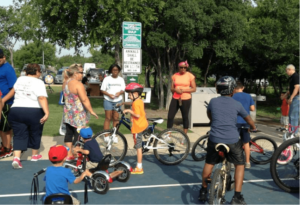This is the first in a series on mental health collaboratives in Texas. Learn more about our strategic focus on communities and collaboration.
To conduct a mental health intervention at the community level requires reckoning with certain caveats and risks. Strategies envisioned too broadly might cause some families to fall through the cracks, while those that opt for a smaller scope hazard the development of exclusionary practices.
In other words, it’s complicated. The ideal intervention not only addresses a community’s most urgent needs, but also fosters and sustains its well-being in the long term. “There are so many layers to supporting a family,” said Elizabeth Lutz, executive director of the Bexar County Community Health Collaborative. “It’s not a cookie cutter approach. It’s not one-size-fits-all.”
The same holds true for the Health Collaborative’s own approach to community intervention. Rather than offer partnering organizations and individuals a mythic cure-all, Lutz and her team function as an administrative “backbone” that synergizes the assets and ambitions of partners large and small.
The aim isn’t to reduce the complexities of community health, but to tackle them head on.
Getting to the Root of Community Health
Although the Health Collaborative has been operating since 1997, its founding partners didn’t formally emerge as a 501(c)(3) nonprofit until 2000. By inviting a slew of additional stakeholders—including clinics, hospitals and community-based organizations—what began as a way to pool resources for a collective needs assessment evolved into a catalyst for community data-sharing, education and other forms of cooperation.
In 2012, the San Antonio Metropolitan Health District (Bexar County’s local health authority) recognized the utility of collaborative strategic planning and enlisted the Health Collaborative to help lead that year’s Community Health Improvement Plan. The 2017 Healthy Bexar Plan is the latest product of their combined efforts.
“Before, there were missed opportunities for maximizing support and leveraging the resources of other community organizations,” said Lutz. “It’s no secret that mental and behavioral health resources are limited. For the first time, we were able to really organize and capitalize on partners that had been doing a lot of the work in silos.”
Comprehensive assessments consistently identified mental and behavioral health as a high-priority focus area—one that Lutz called a “root cause” of barriers to community wellness. The Health Collaborative recognizes, however, that a family’s mental health struggles can’t be isolated from other sources of unrest.
That’s why establishing sustainable partnerships between organizations inside and outside the mental health arena is so vital. “Sometimes we’re matchmakers,” said Lutz. “We introduce organizations to each other, help develop trust and begin the conversation. Once we see that the relationship is there, we step away and allow that to naturally grow.”
In Community Health We Trust
Although the significance of the Health Collaborative’s many roles—which range from organizer and facilitator to instigator and advocate—can’t be underestimated, Lutz stressed that once a door has been opened, the partners and community members take the lead.
“We’re here to understand—and through that understanding, we can coordinate how and when to maximize their resources,” she said. “We don’t want to overburden one agency and leave another out in the cold. This is about distributing the work and the needs of our community.”
The success of the collaborative is owed to the diversity of its players, whose wide variety of expertise and perspectives influences and formulates the interventions staged within this framework. The Youth Health Advisory Council, for instance, is a cohort of youths whose lived experience of mental health issues sets the agenda for the Young Minds Matter program. Likewise, a community council of 12 different faith leaders gathers every year to host the Pathways to Hope mental health conference, sponsored by the Health Collaborative and free to all who wish to attend.
This spring, the Health Collaborative will launch a Pathways Community HUB project—the first of its kind in Texas. First developed in Ohio, the evidence-based model utilizes community care coordinators to help families navigate and overcome all sorts of barriers to well-being, such as housing, transportation, employment, and behavioral health.
“We’re supporting partners that already have a workforce,” said Lutz, “giving them a sustainable funding stream so those community health workers can perform holistic coordination services.”
Previous attempts to conduct such an intensive deployment and coordination of resources have fallen short, usually due to a crucial lack of trust or inadequate grasp of community dynamics. But this time, the Health Collaborative has managed to meet with and get buy-in from more than 80 community partners.
“There’s a big need for us to really understand what families are struggling with, where their top priorities are, and what truly is preventing them from living and being well,” said Lutz. “We’re hopeful that this intervention will at least shine a light on some of that.”
Related: Collaborating for Social Impact: Lessons from Bexar County (podcast)

